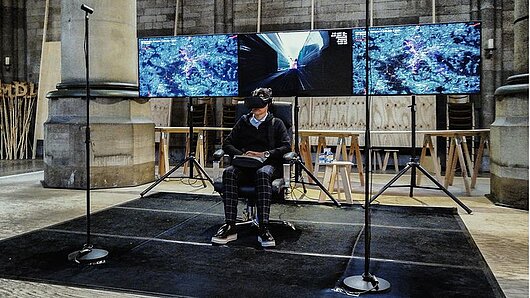High-Performance Computing Center Stuttgart

As part of the Drehmoment Produktionskunst-Festival, organized by the KulturRegion Stuttgart, digital artist Michael Saup undertook an intervention in collaboration with the High-Performance Computing Center Stuttgart (HLRS) that set out to make particulate pollution visible. In a virtual reality project called Staub (Dust), Saup makes it possible for viewers to enter a virtual reality environment that renders actual measurements of particulates in the city's air.
The concept for Staub began developing in December 2017, when Saup visited HLRS and met with members of the center's Visualization Department. During the exchange, Saup described his artistic practice, which uses digital tools to address issues related to energy and its effects on nature and society. The HLRS team displayed some of its 3D visualization work, including a visualization of air pollution in Herrenberg, a small city south of Stuttgart.
The exchange of ideas resulted in an installation that is on view in St. Maria's Church in Stuttgart through October 28, 2018. The artwork integrates and, using software programmed by the artist, interprets sensor measurements of particulate emissions and integrates them with open-source street imagery and real-time data about traffic conditions to represent clouds of air pollution in virtual reality. Visitors to the installation can wear a VR headset to explore the space.
HLRS also assisted Saup by creating 3D digital scans of physical sites around the city, including a playground near the Neckartor, a location is consistently burdened with high concentrations of particulates. Saup is planning to integrate these scans into his project as well.
"As an artist it is inspirational to work with people who use similar tools but have a completely different sense of what to do with them or why," Saup says. "Exchanging ideas with people working in computing, artificial intelligence, or robotics can lead to new narratives about the future and what it could look like."
The Drehmoment Produktionskunst-Festival is an initiative of the Kultur Region Stuttgart, an organization that brings together 43 nearby municipalities to cultivate the cultural identity of the region. According to festival curator Benjamin Heidensberger, "The basic hypothesis of the festival is that our region stands on the threshold of an enormous transformation, not only with respect to the automobile industry but also regarding other questions related to globalization and digitalization. Drehmoment is an attempt to stimulate thought and action related to these themes."
In addition to Staub, the exhibit at St. Maria's Church includes work by Dietmar Offenhuber, called Staubmarke (Dust Traces). Offenhuber's project involved conducting "reverse graffiti," in which he left stencils on clean surfaces around the city for weeks or months at a time. The resulting traces constitute physical markers of air pollution, an approach that complements Saup's virtual exploration.
Drehmoment also includes dozens of other artworks located at other sites in the Stuttgart region that developed from interactions betwen artists and industry. The festival runs until October 28, 2018.
—Christopher Williams